Hello, I’m Artem, Team Lead in the Publisher Department at Adsterra, bringing five years of experience to the world of traffic monetization and the main question I’ll highlight today, which is how to earn from ads.
Common aspiration to make money online among our publishers couldn’t go unnoticed for me. However, many are uncertain about where to begin. I’ve come across numerous queries, and this article serves as a comprehensive guide aimed at addressing these very questions.
In this guide, I aim to provide you with a systematic, step-by-step tutorial on launching your online business from the ground up. In particular, I’ll tell you how to earn money from your website with Adsterra ads. This article is dedicated to those with limited initial budgets and minimal experience. Nevertheless, I believe it will also prove valuable to intermediate-level publishers.
So, let’s dive right in.
How to earn from ads: all you need to know about websites
It’s essential to understand the technicalities of your website before learning how to earn money from advertising with significant income. Let’s dive deeper into the different sections that make up a website.
The focus of your website
To earn money online, you need three fundamental components:
- Website
- Traffic
- Ads
Our business model is straightforward: drive traffic to your website and earn revenue through advertisements.
Before you embark on this journey, it’s essential to determine the focus of your website. Choosing the right niche is very important.
Let’s explore copyright-safe options that abide by all legal regulations.
On a global scale, websites can typically be categorized into two main types:
- Tools Websites: Tools websites offer users access to specific functionalities. Some examples:
- URL Shortener
- File Converter
- Credit Calculator
- Currency Converter
- Weather Forecast
- Image Editor
- Story Generator, etc.
The advantage of tools websites is that they don’t require daily content creation, making them an excellent source of passive income. - Blogs and Informational Websites: This category primarily involves text-based content and covers a wide array of topics, including:
- News
- Celebrity Gossips
- Tutorials
- Funny Stories and Memes
- Computer Gaming Blog
- Android Application Reviews
- And many others.
If you possess strong writing skills and a passion for sharing your perspective, you can select a niche that resonates with you and create engaging content.
Remember, the key is to choose a niche that aligns with your interests and expertise, as this will enable you to produce content that captivates your audience.
Domain Name
Once you’ve made your decision about the focus of your website, it’s time to proceed with purchasing a domain name and setting up hosting.
It would be better if your domain name is relevant to your website niche. Include keywords into your domain name.
You can visit https://www.expireddomains.net/ to find some aged domains with history. Maybe you would be lucky enough to find a diamond. Dropped domain with history, authority, and existing backlinks would speed up ranking and traffic flow.
There is an instruction how to use this tool here: https://member.expireddomains.net/article/introduction-to-the-member-area-15109.html
When you find some interesting domain name, check its history. You don’t want to buy a domain name formerly involved into scam activity. Use https://web.archive.org/ to see what this website looked like in the past.

If domain is ok, you can buy it. Or you can create absolutelly new domain name without any history.
The price depends on many factors, such as TLD (symbols after dot), number of words, premium or not, current discounts, etc. Usually, if it is not a premium domain, the prices are:


Hosting
Website hosting is like the digital real estate where your website resides. It’s a service that provides the necessary infrastructure for your website to be accessible on the internet.
There are several types of website hosting available, each tailored to different needs and preferences.
If you check any hosting provider, you would see the following options:
- Wordpress Hosting. The prices looks delicious. But don’t make a wrong decision. If you read the specifications carefully, you would see that there is a serious monthly visitors limit.



Let’s count together. 10k per month is only 333 users per day. 100k is only 3333 users per day. This is not what we are aiming for. It would be better to think two steps ahead and consider scalability.
If you are planning to drive traffic from Social Media, you might have spikes of traffic due to the virality. You may take a look here:
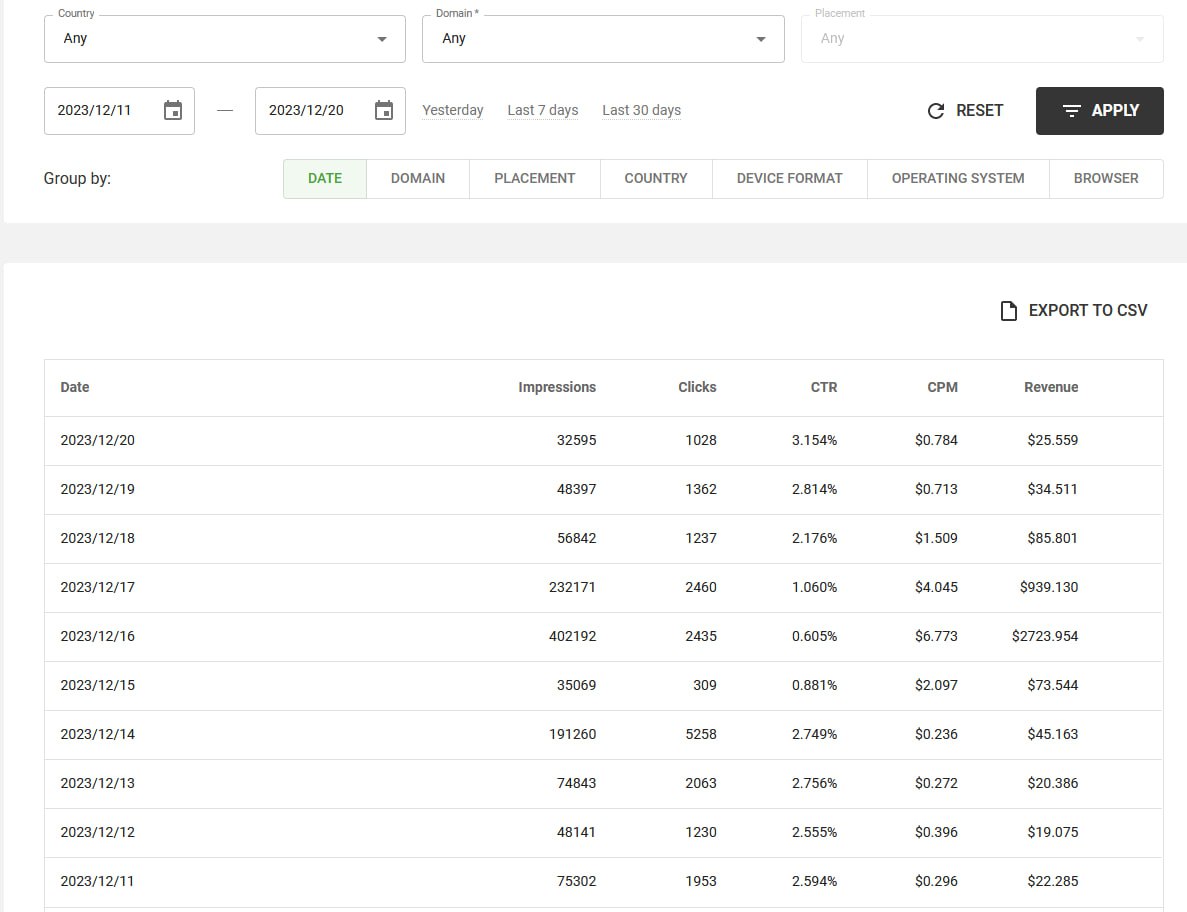
Also, Wordpress Hosting owners share the resources with all other people, and if your neighbour eats all resources, your website becomes slow, and it is not very good for your ranking, site loading, and even ad opening.
- Dedicated Server. It’s the best option if you already have money. Dedicated Server gives you top tier performance.
But if you are in the beggining of your online journey to make some cash, you should consider another option.


- VPS (Virtual Private Server). It is a golden middle. You don’t have any restrictions in the amount of users per month. You have your own resources. And the price is lower compared to Dedicated Server.
It’s possible to find some options from $5.50 per month.


Using VPS server requires some skills.
I recommend to choose a VPS server with pre-installed Linux OS. It would be relatevilly easy to install SSL and Wordpress using SHH client. What is SSL, SHH, and why do you need it? Read further.
SSL
With SSL in place, your website’s URL begins with “https://” instead of “http://,” indicating a secure connection. This not only provides a sense of safety to your visitors but also boosts your website’s visibility in search results, ultimately attracting more traffic and instilling trust in your online presence.
Without an SSL certificate, your website may struggle to achieve a good ranking on Google. This is because search engines, including Google, prioritize secure websites in their search results. When users see “Not Secure” warnings next to a web address, they’re less likely to trust and engage with your site.
CMS
CMS stands for “Content Management System”. It is a software application or platform that allows users to create, manage, and modify digital content, typically for websites and online platforms.
I recommend for all you begginers a Wordpress CMS. It is easy to install and use. You don’t need to be a programmer to work with Wordpress. And there are a lot of tutorials on Youtube and Blogs all around Google.
How to set up your VPS hosting
First select your VPS hosting provider.
Secondly choose your VPS hosting plan according to your budget and estimated traffic volume, and any resources you need.
You need to select Linux Ubuntu 20.04 as an OS for your server.
We can use terminal to install anything you need on your Linux server. But as a begginer, you’d better use a web-based control panel for managing your system.
The most popular control panels are CPanel, Plesk but they are paid. Webmin is free, that is why I will show you what to do if you use Webmin. Webmin allows us to install Virtualmin, which will help us install Wordpress.
LAMP is a bundle of Apache, PHP, MYSQL, and PHPmyAdmin. You just need it, trust me.
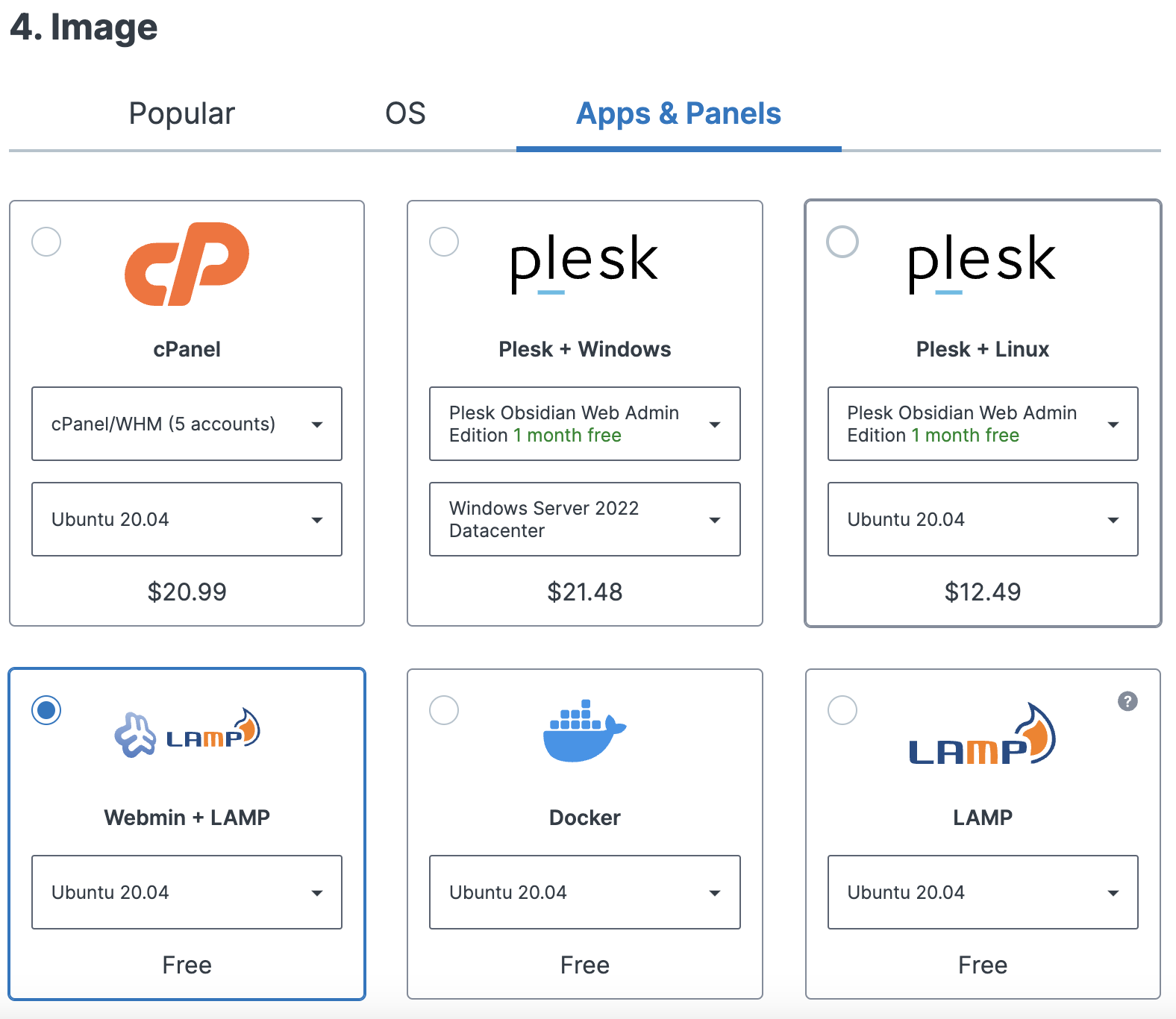
When you proceed further you will create a password, which you will use to aceess your server with SHH tool. We will talk about it later.
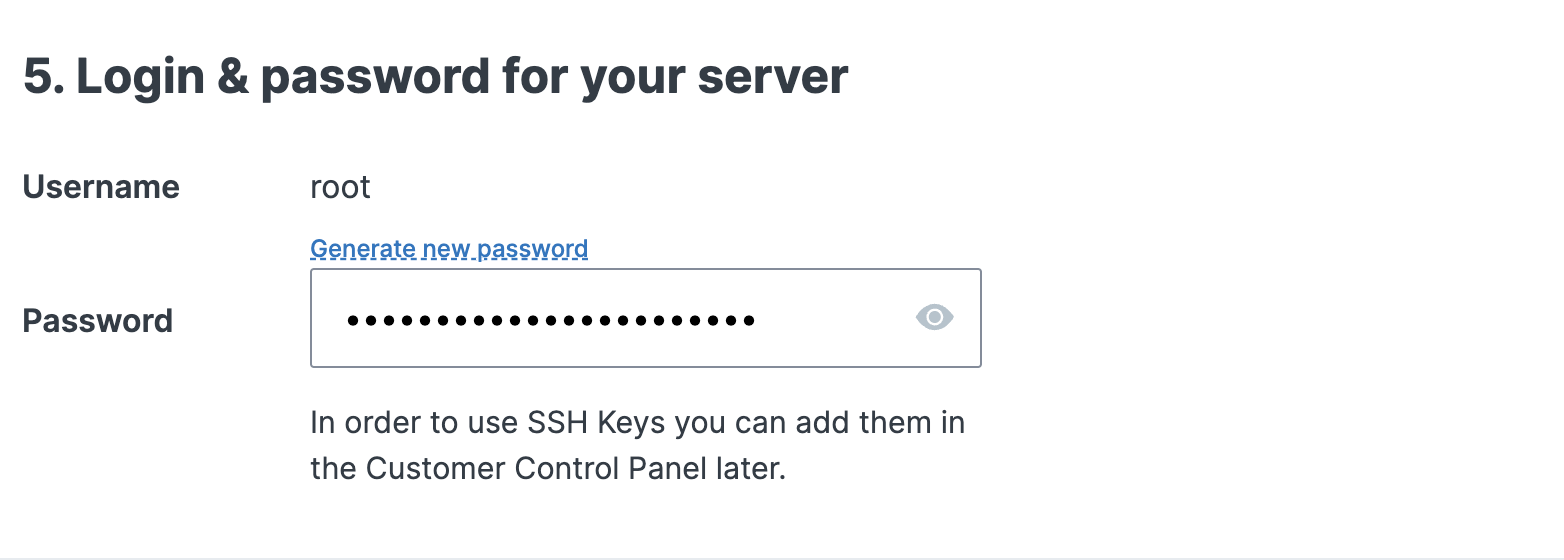
When you finished your order you would recieve an email with your credentials.
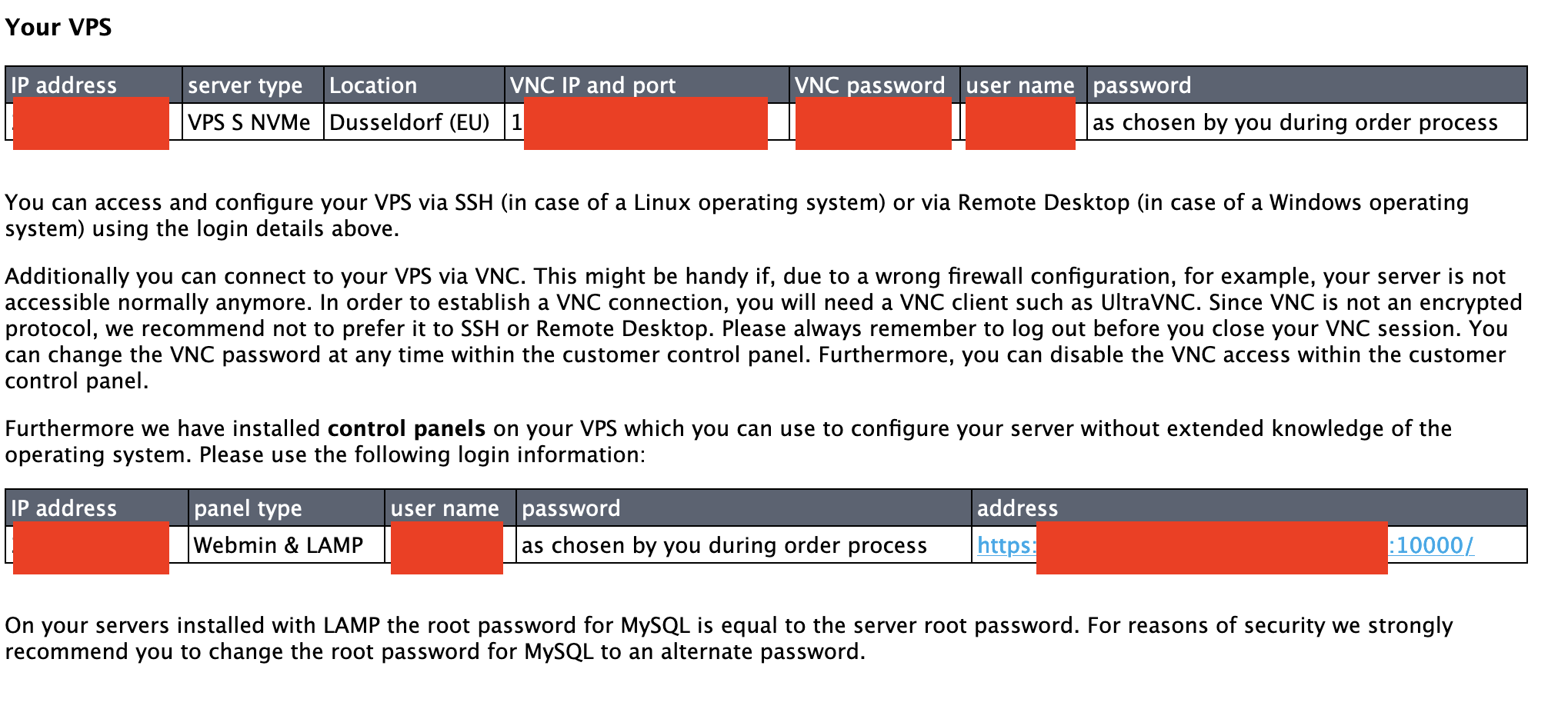
Now you need to connect your domain name and your server. Copy IP address from your letter and save it somewhere near.
Connecting domain name to your server
Log into your domain name register account (Namecheap, Godaddy, or any other).
Go to Advanced DNS settings and create two new A Records. One with @ and another with www in the Host column.
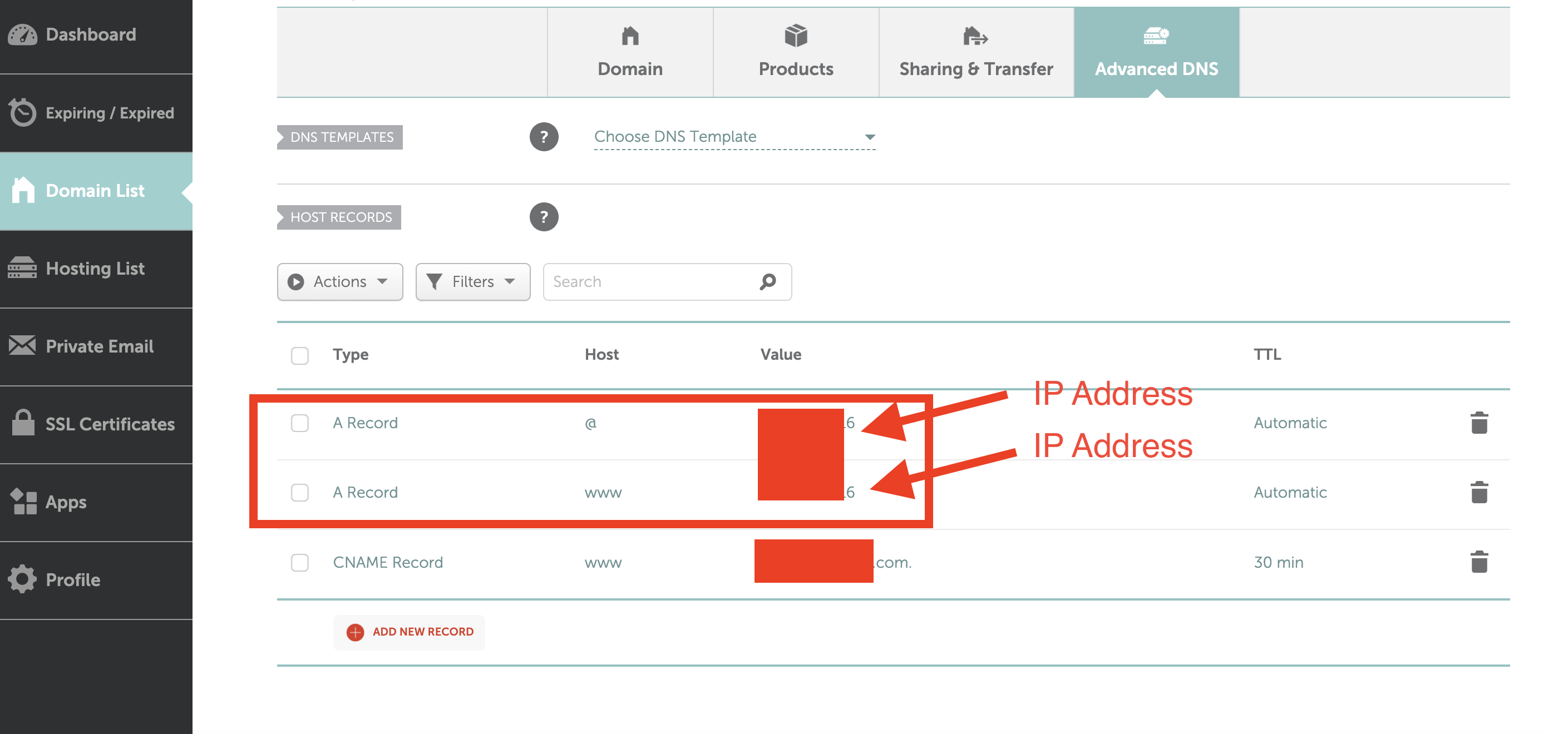
Also create MX Record with @ Host and domain name in the Value column.

Installing Virtualmin
We will install Virtualmin like a pro via console. SSH is a secure network protocol that is commonly used to remotely control servers, network devices, and other devices.
The most popular SSH tools are: PuTTY, SecureCRT, Termius, and others.
Log into your server using SSH tool. You will need an IP address, username from the letter, and Password you created before when made a purchase.
Here is Termius on the picture.
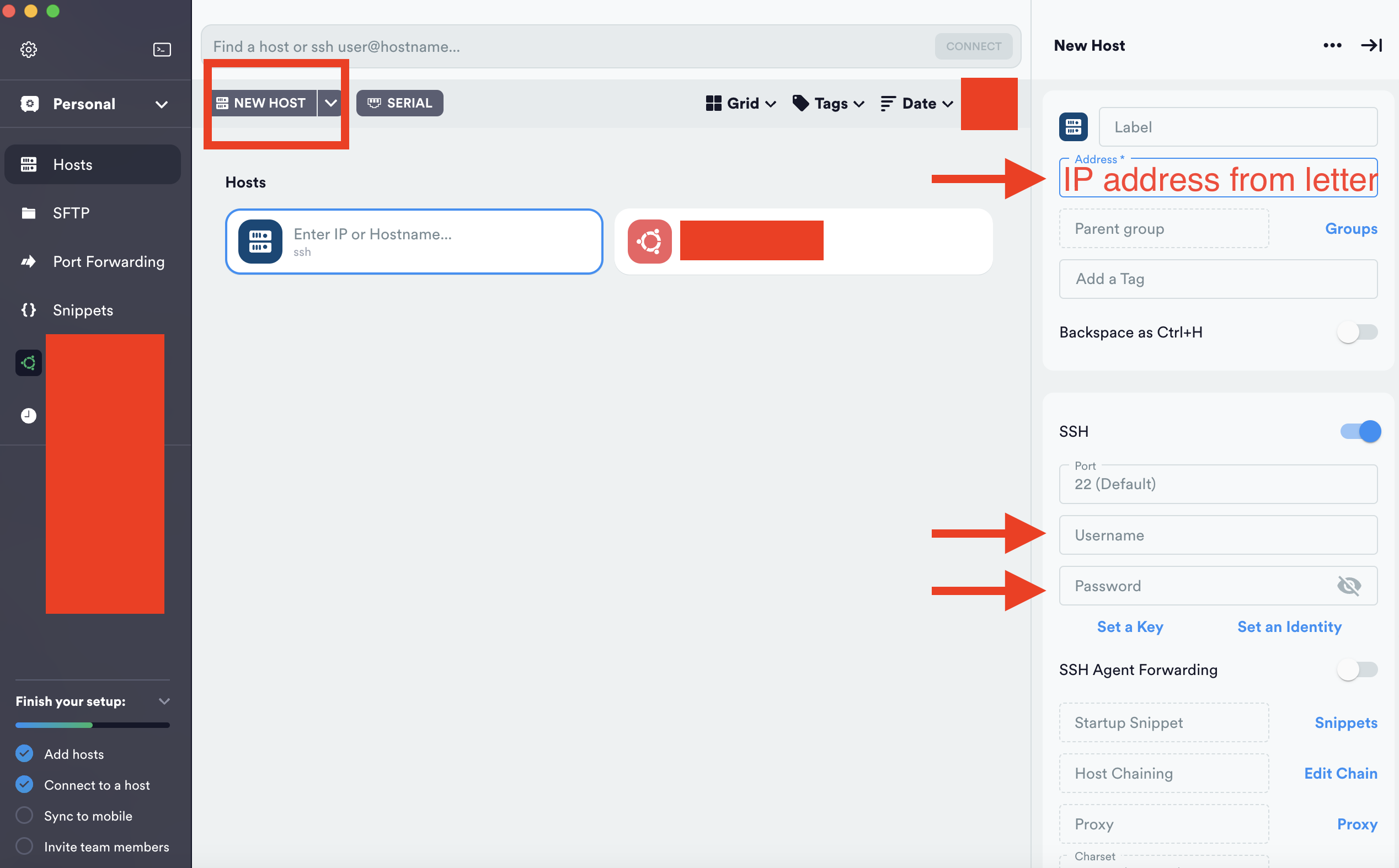
After you connect there would be black screen with some letters inside. This is Command Line Interface. You can enter the commands and magic happens.
Now we need to install SSL cerificate and Wordpress. To install Wordpress on Webmin we need to install Virtualmin before. Virtualmin is used for managing websites (think of it as a control panel for managing websites, such as a cPanel alternative), while Webmin is more of a server management tool (used to manage system related services).
Virtualmin is a powerful control panel that can be installed on top of Webmin to manage and simplify the administration of virtual hosts (multiple websites) on a web server. To install Virtualmin on a server with Webmin, follow these steps:
Important: Before you proceed, make sure you have a clean, freshly installed Linux server, and you have root or sudo privileges.
- Update Your Server: Ensure that your server’s package repositories are up to date by running the following command:
sudo apt updateor
sudo yum update - Install Webmin: If you haven’t already installed Webmin, you can do so by following the instructions for your specific Linux distribution. For example, on Ubuntu, you can use the following commands:
sudo sh -c 'echo "deb <http://download.webmin.com/download/repository> sarge contrib" > /etc/apt/sources.list.d/webmin.list' wget -qO - <http://www.webmin.com/jcameron-key.asc> | sudo apt-key add - sudo apt update sudo apt install webmin - Access Webmin: After the installation is complete, you can access Webmin by opening a web browser and navigating to
https://your-server-ip:10000/. Log in using your root or sudo user credentials. - Download the Virtualmin Installation Script: Download the Virtualmin installation script using
wgetorcurl:wget <http://software.virtualmin.com/gpl/scripts/install.sh>or
curl -o install.sh <http://software.virtualmin.com/gpl/scripts/install.sh> - Run the Installation Script: Make the script executable and run it:
chmod +x install.sh sudo ./install.shThe installation script will guide you through the installation process and ask you questions about your server’s configuration. Follow the prompts and provide the necessary information.
- Access Virtualmin: Once the installation is complete, you can access Virtualmin by opening a web browser and navigating to
https://your-server-ip:10000/. Log in using your Webmin credentials.
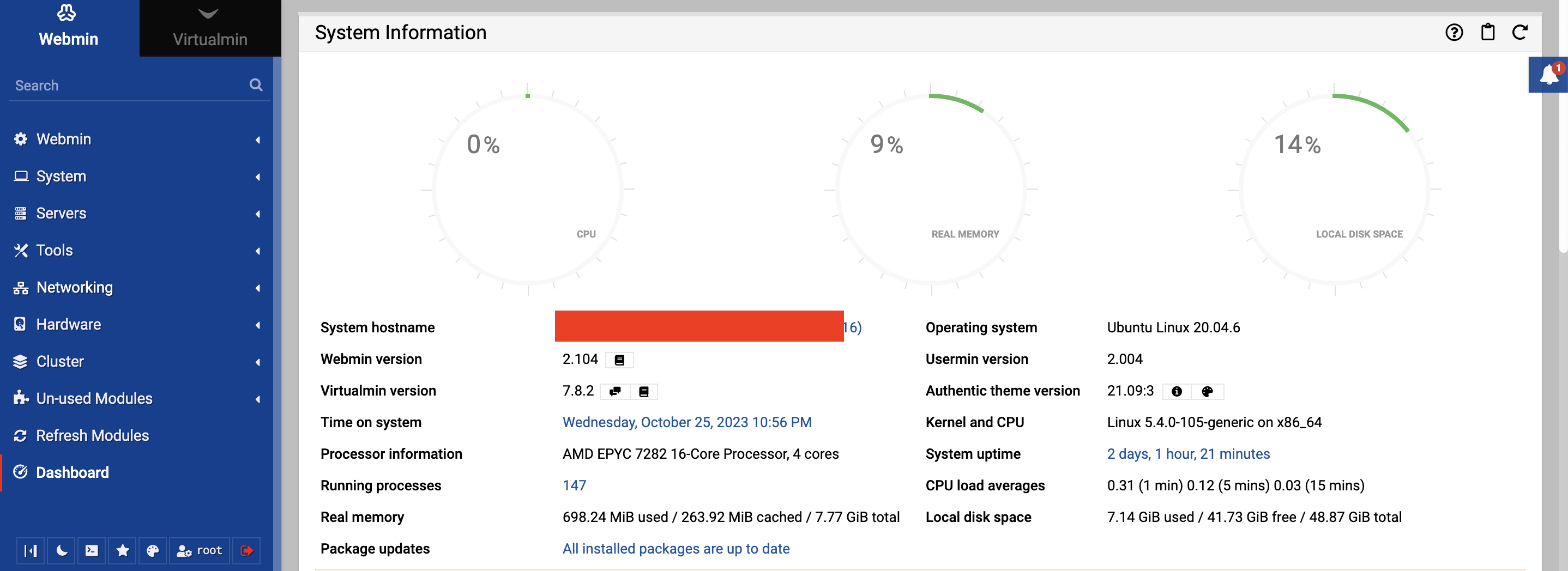
That’s it! You should now have both Webmin and Virtualmin installed on your server, and you can use Virtualmin to manage virtual hosts and websites on your server. Please note that Virtualmin may have additional system requirements and compatibility with specific Linux distributions, so make sure to check the official documentation for any specific guidance related to your environment.
Installing Wordpress and SSL certificate
First of all you need to create a virtual server.
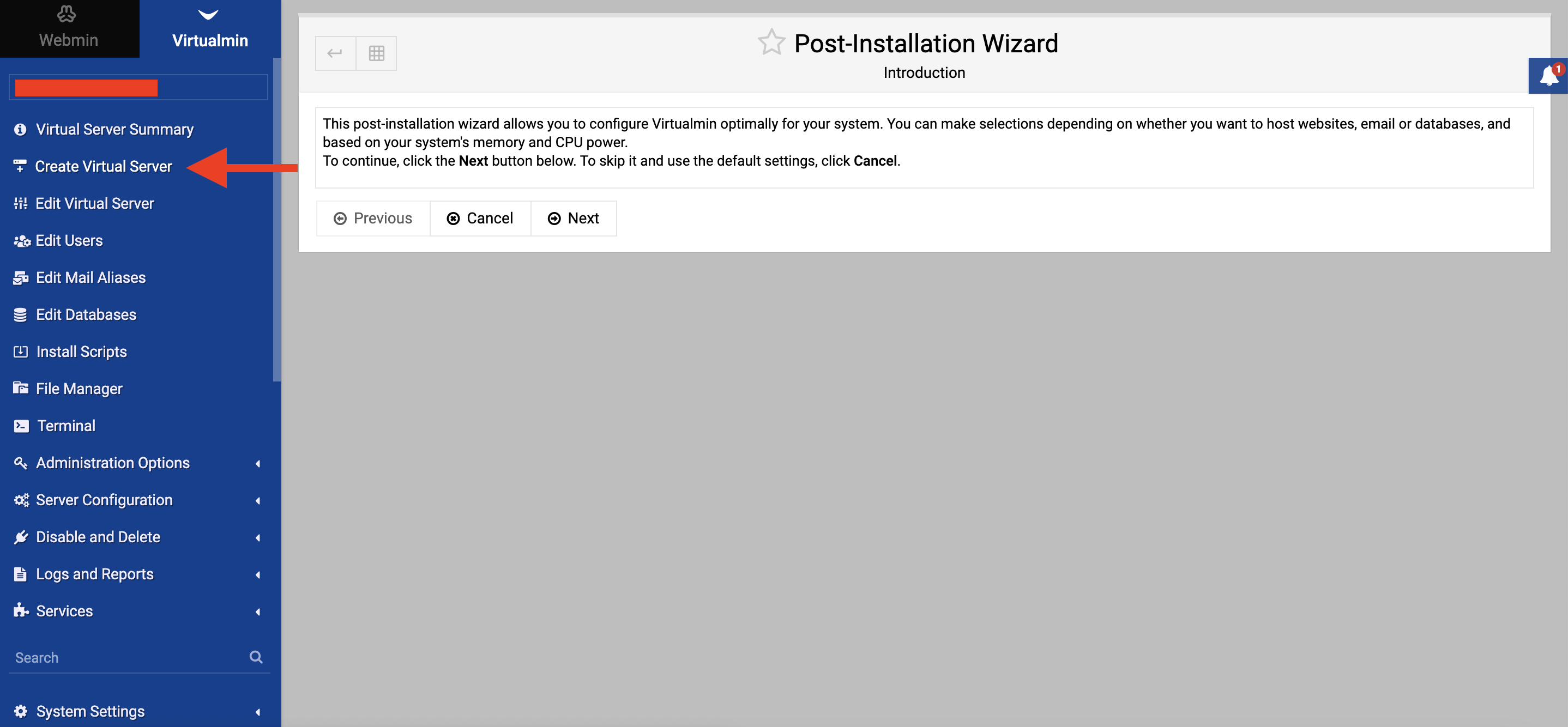
Enter Domain name, write a description, create a strong password.
Enable all necessary features.
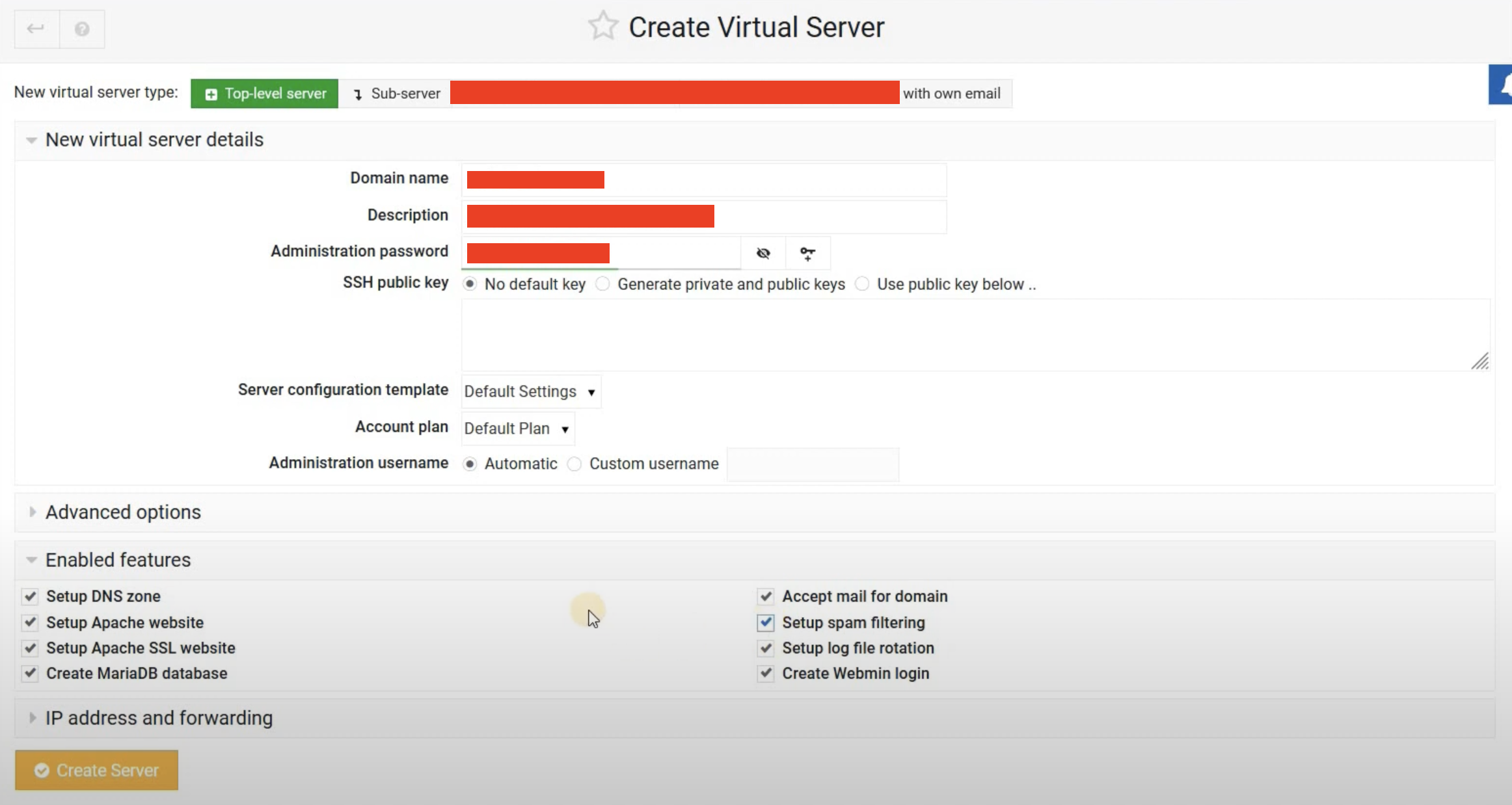
And hit the Create Server button.
Go to server configurations, and then PHP options.
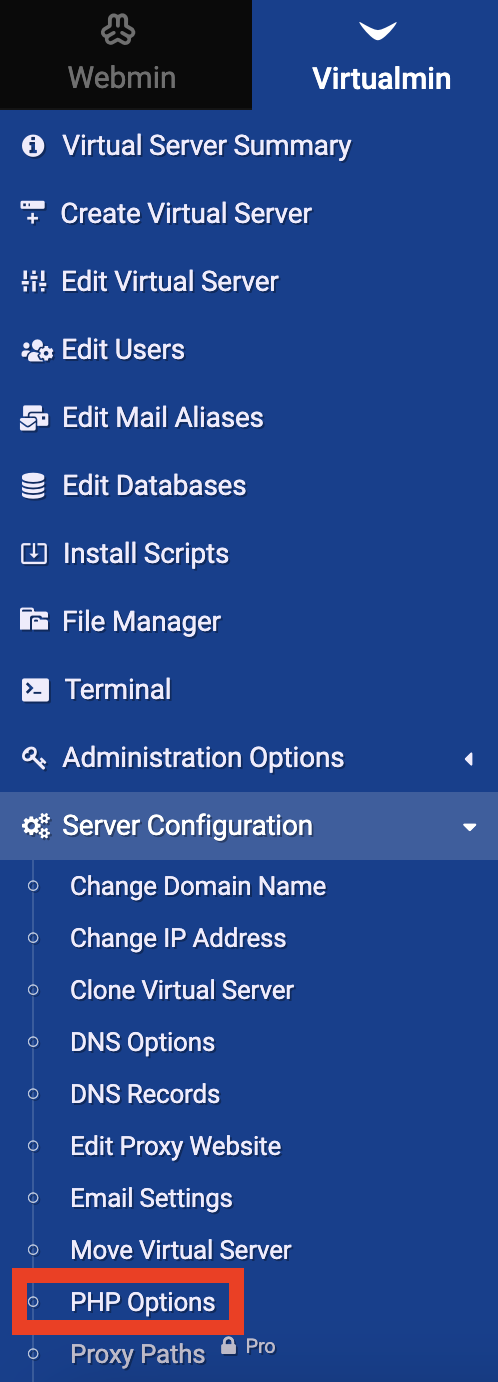
Select FPM and click Save.

Click Install Scripts and find WordPress. Click green V symbol near it.
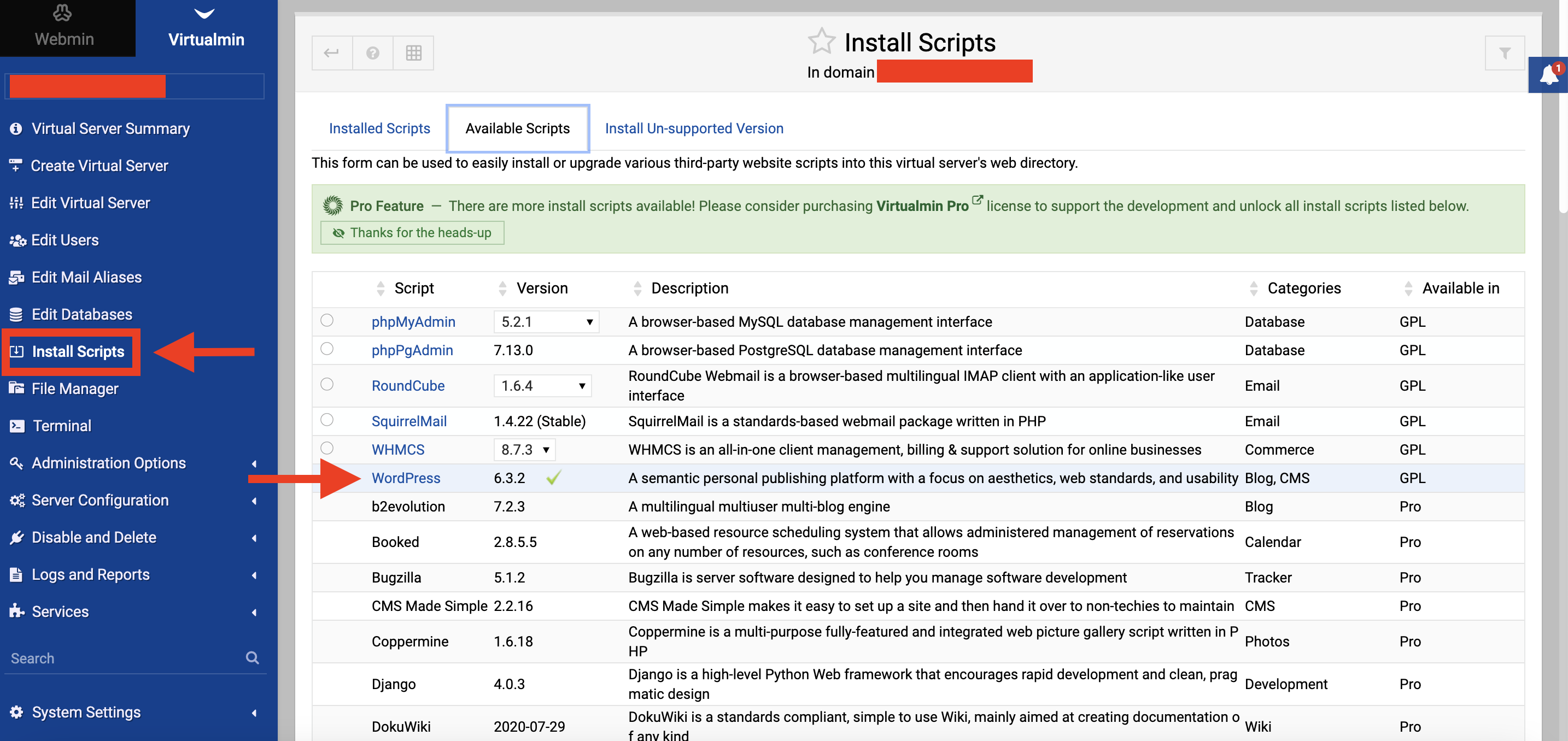
Create Username and Password for your WordPress site. You will log into your website admin panel using these credentials.
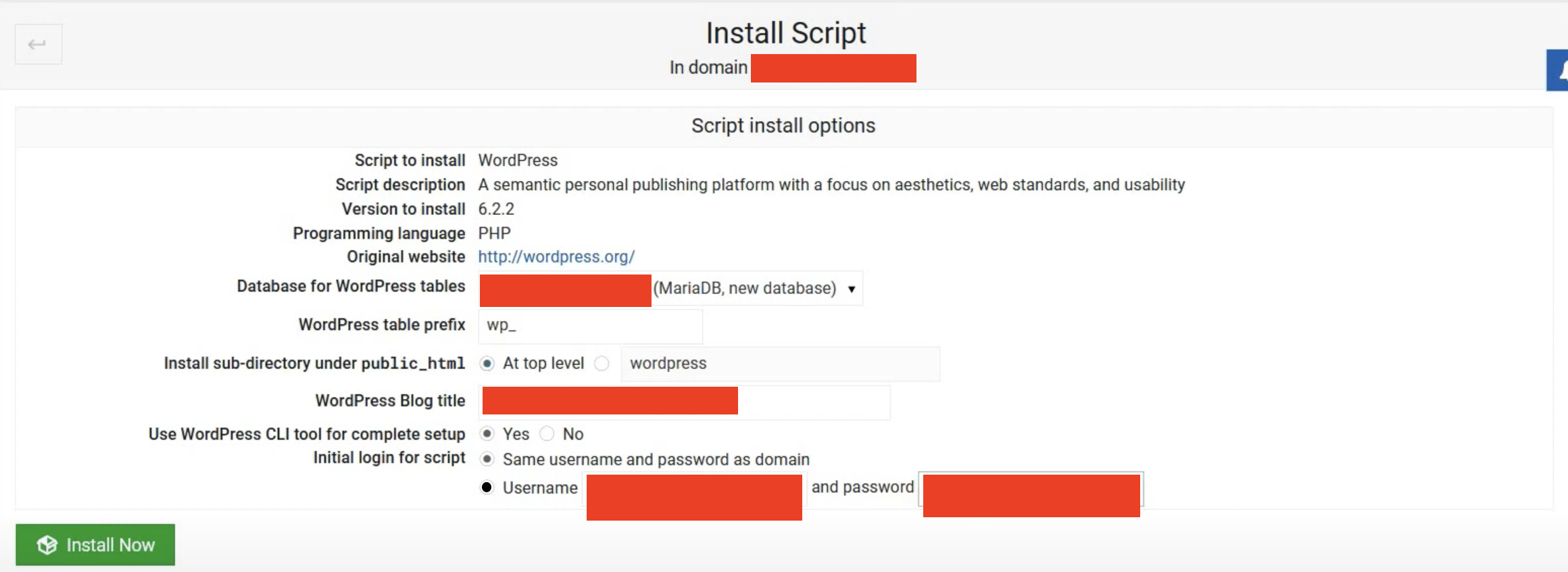
Click Install Now. Done.
Installing SSL cerificate
Go to the Server Configuration. Click SSL Certificate.
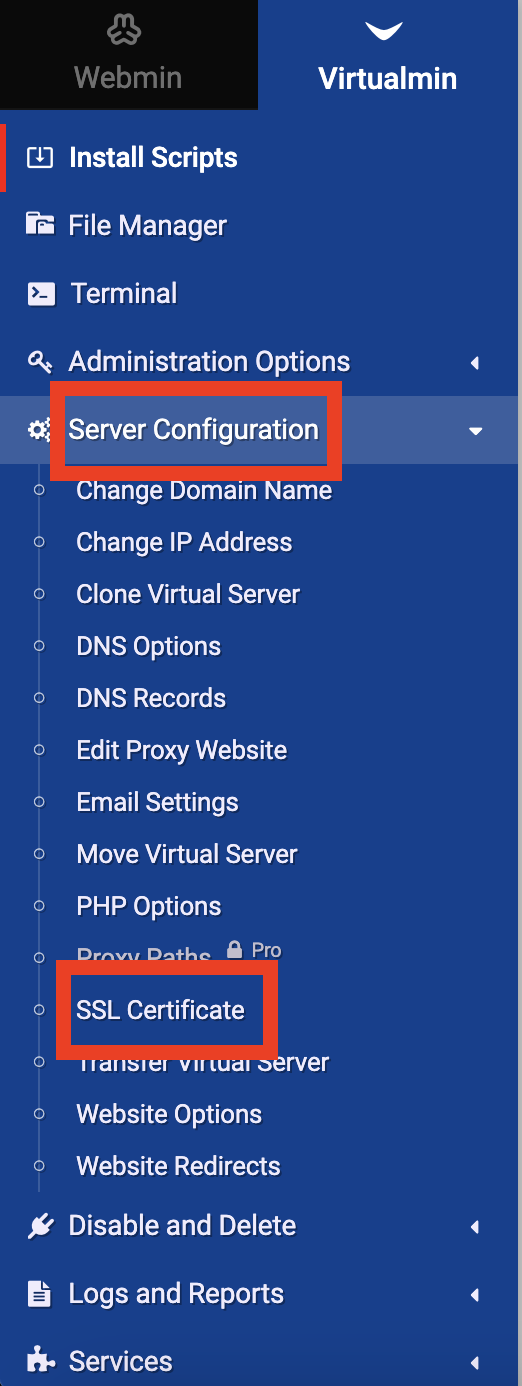
Click Let’s Encrypt.
Hit the radio button Domain names listed here and type in your domain name and domain name with www.
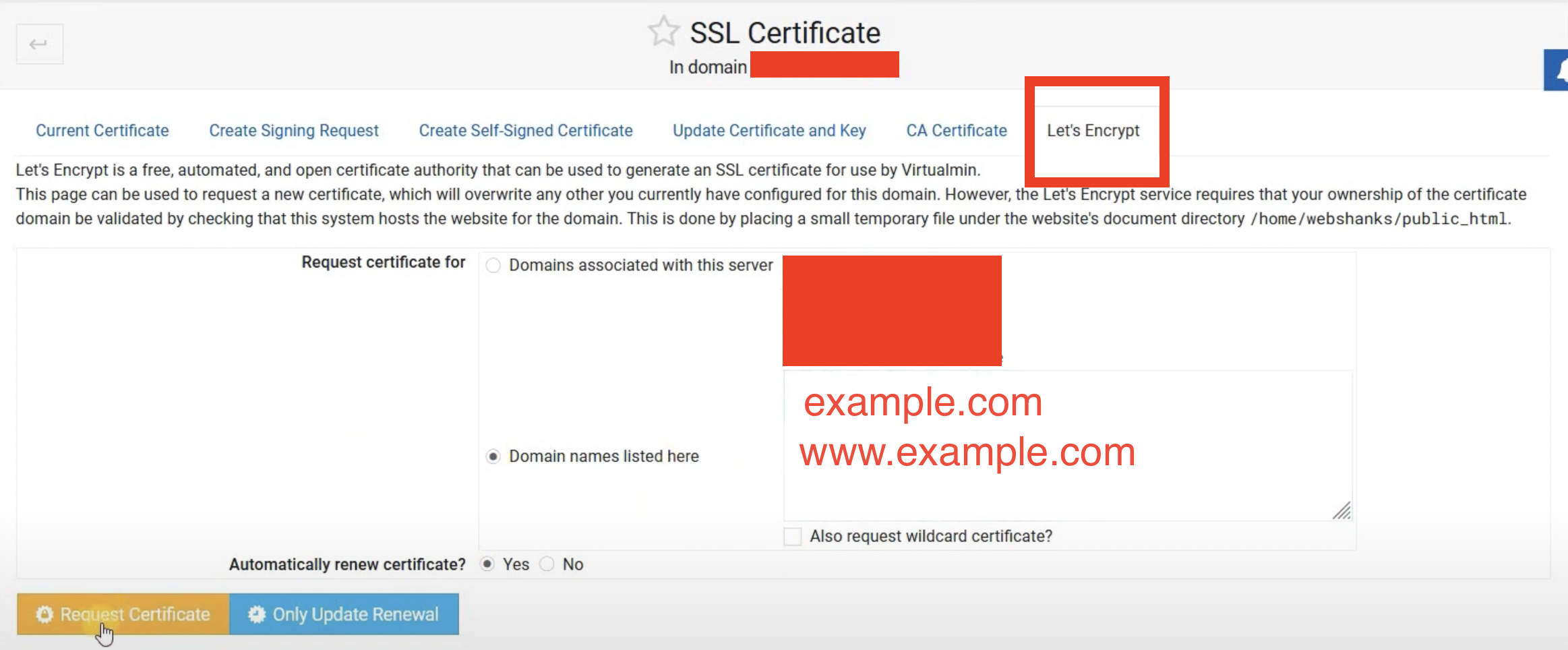
Click Request Certificate.
Go to Server Configuration. Click Website Options. Redirect all requests to SSL site – Yes.
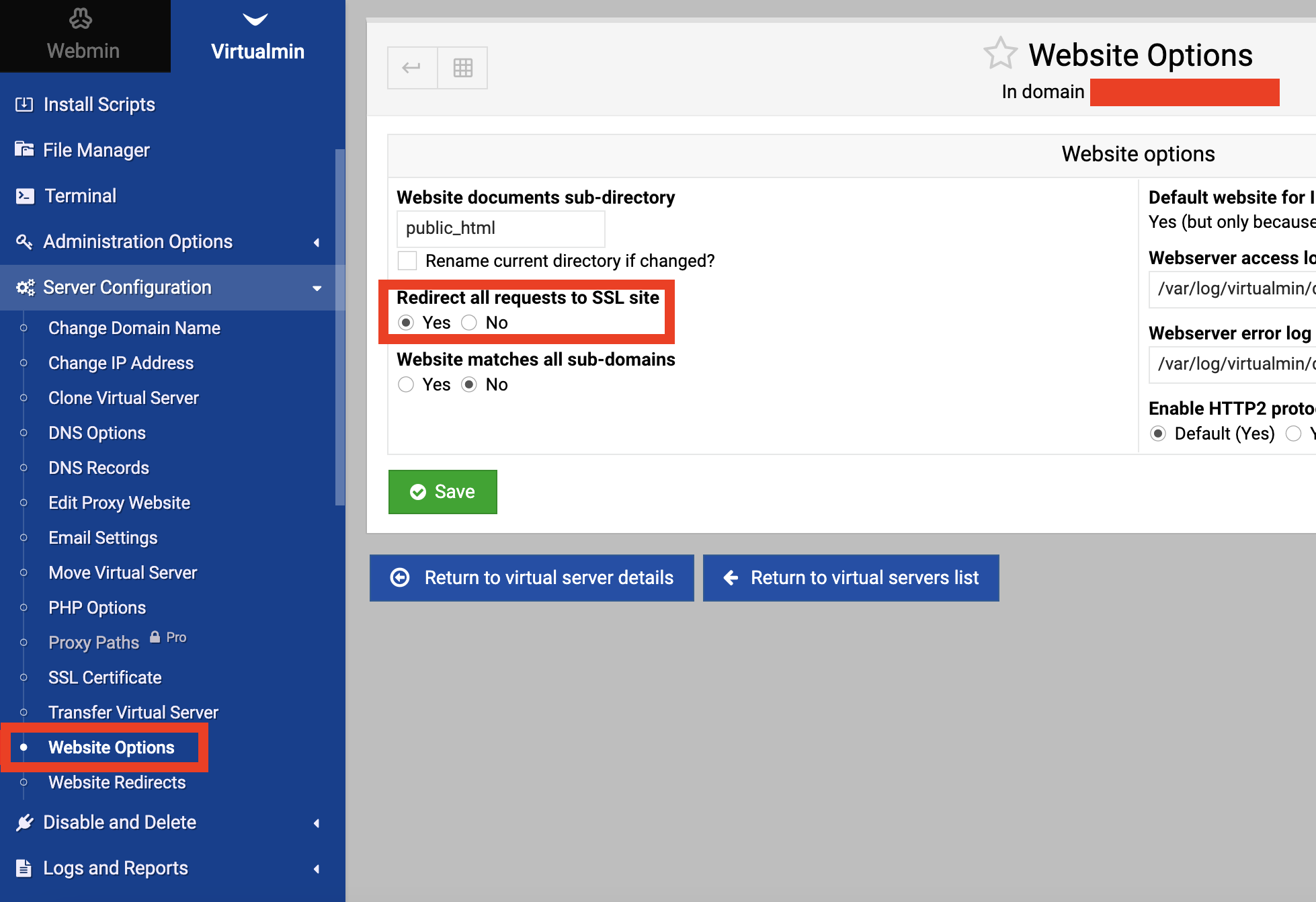
Save.
You are a delight! Now you can log into your Wordpress site.
To access your admin login page go visit your website and write /wp-admin/ after it.
For example https://example.com/wp-admin/
Wordpress Theme
A WordPress theme is a pre-designed template or framework that determines the overall look, layout, and design of a WordPress website.
There are thousands of free and premium WordPress themes available, and you can choose one that best aligns with your website’s purpose and aesthetic preferences.
You’ll want to prioritize themes that are lightweight, well-optimized, and built for speed. Here are some popular and fast-loading WordPress themes that you can consider:
- Astra: Astra is a highly customizable and lightweight theme known for its speed and performance. It’s compatible with popular page builders and offers a range of starter templates to help you get started.
- GeneratePress: GeneratePress is another fast and lightweight theme. It’s designed with speed in mind and is fully compatible with popular page builder plugins. It offers a variety of customization options.
- Neve: Neve is a lightweight, SEO-friendly, and fast theme. It integrates well with popular page builders and is suitable for a wide range of website types.
Before selecting a theme, be sure to check its compatibility with your specific plugins and website requirements. Additionally, consider your design preferences and the type of content you’ll be publishing. It’s a good practice to run performance tests on your chosen theme to ensure it meets your speed expectations.
Plugins
Plugins are extentions which gives your website extra functionailty features.
The most notable are:
Elementor – allows you to customize your website layout.
IndexNow – makes auto submissions to the search engine and helps be visibe on the Internet.
WP File Manager – allows you to upload and download files from server.
WPCode Lite – add code snippets without editing your source code. Essential to add ad codes.
Yoast SEO – analize on-page content, create XML sitemaps, and other things which help you improve your ranking.
WP 2FA – Two-factor authentication for WordPress – protect your website from hacker attacks.
Site Kit by Google – connect Google Analytics to your website.

Traffic
I recommend going all out and using every trick in the book to drive traffic, whether it’s free or paid. But beware using fraud and bot traffic.
SEO Traffic
When users type words into search engines like Google or Bing, these engines work their magic to find websites that might have the answers users seek. To make the most of this, you’ve got to remember two important things:
- Get Noticed by Search Engines: Your website needs to be visible to search engines like Google and Bing.
- Get Noticed by Users: Equally important is that your website should be easy for users to find.
The first part is handled with the help of WordPress plugins. You’ll need:
Yoast SEO: This plugin helps you create a sitemap, structure your blog posts, generate custom thumbnails for social sharing, and even rates your content’s readability.
IndexNow: This one automatically gets your site indexed by Bing Search Engine.
Site Kit by Google: Use this to connect your website to your Google Analytics account. This way, all your pages and blog posts become visible to search engines, and users can discover them.
However, just getting to the second page of search results won’t do you any good. That’s where the real competition begins, and the number one spot is where the magic happens.
It’s tough, but here’s a secret: keywords have two key metrics – “keyword difficulty” and “estimated search volume.”
If the keyword difficulty is low, it’s absolutely possible to rank number one for that keyword. How? You’ve got to outshine your competition with high-quality content. Write a comprehensive article that incorporates those low-competition keywords you’re targeting. Beat your competitors with better, more valuable content, and you’ll be on your way to the top spot in search results.
How to find low competition keywords?
Indeed, there are various platforms and tools that can help you assess keyword difficulty and make informed decisions about your SEO strategy and respectively find out how to earn from ads more effectively. Here are a few notable ones:
SEMrush
Similarweb
Ahrefs
Moz Keyword Explorer
KWFinder
Ubersuggest
Google Keyword Planner
Let’s look at an example using a random keyword and a keyword difficulty metric from one of the popular SEO tools.
Imagine you have a website about gadgets and computers. Go to Google and serch for something connected to your niche. Let’s say “how to install Linux”. You would see what websites work in the same niche. Copy their names.
After that go to any platform and find one of these domains.
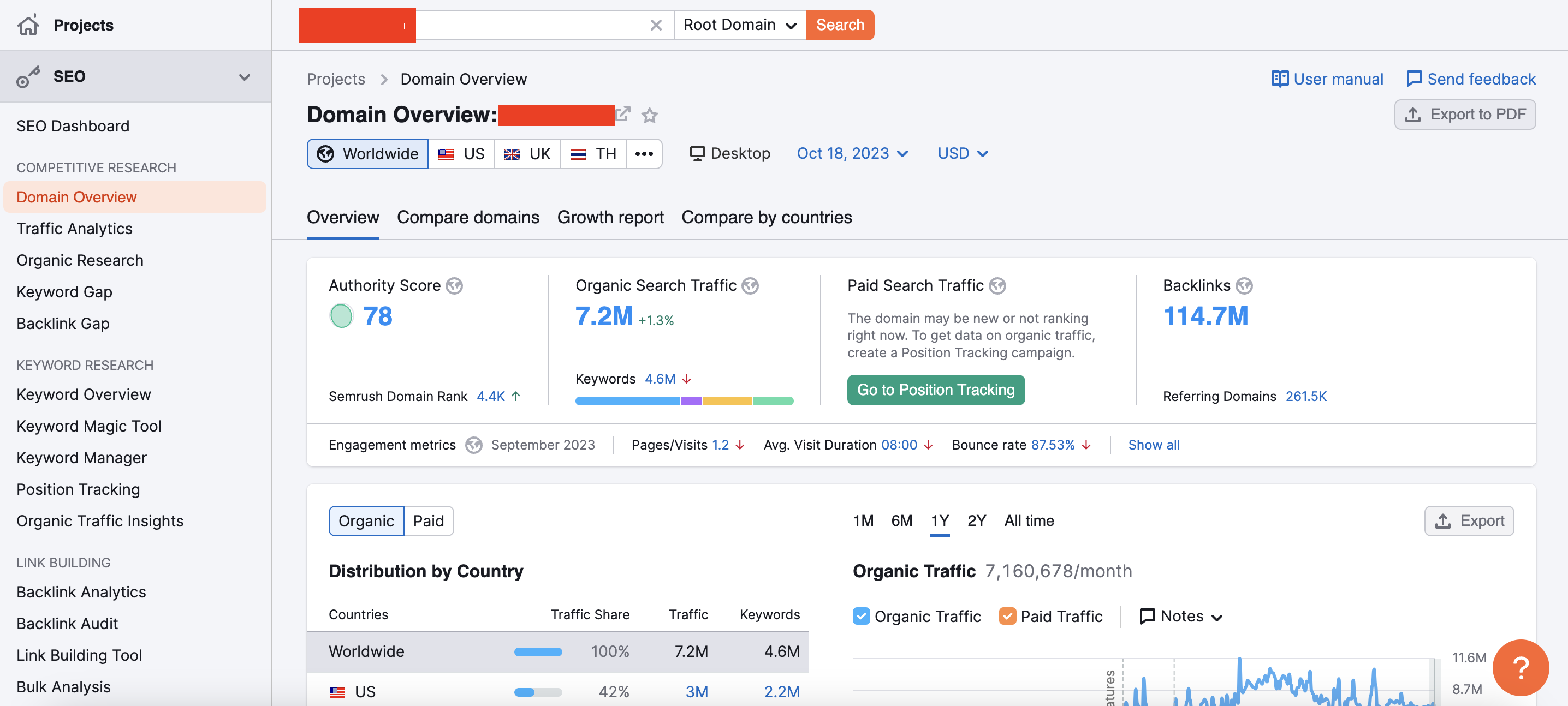
Scroll down and you would find Top Organic Keywords.
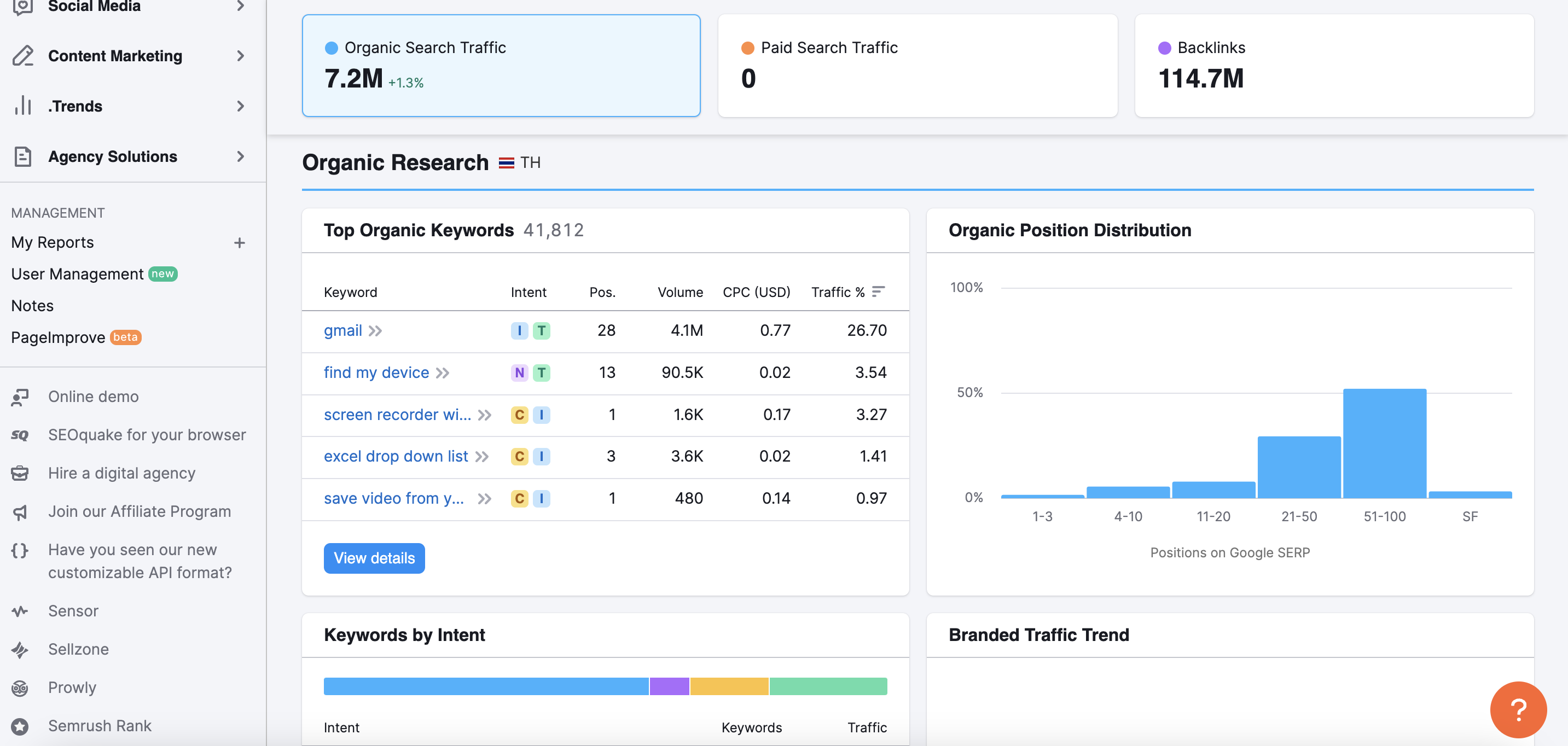
Click View Details and you would see a table with all the keywords. Sort by Keyword difficultie.
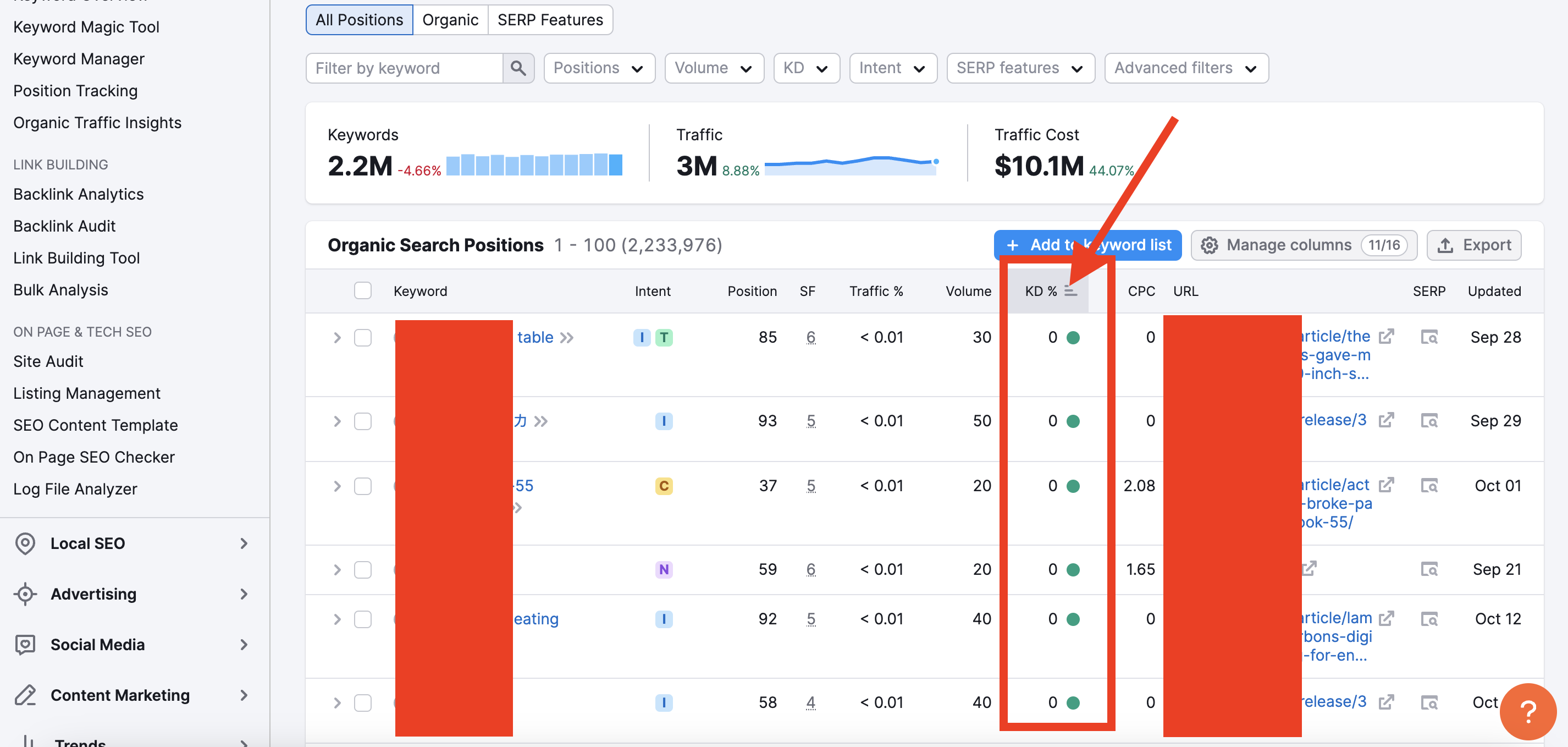
Now download CSV file and upload it to your Google Spreadshit. Use Export button to download the Keywords.
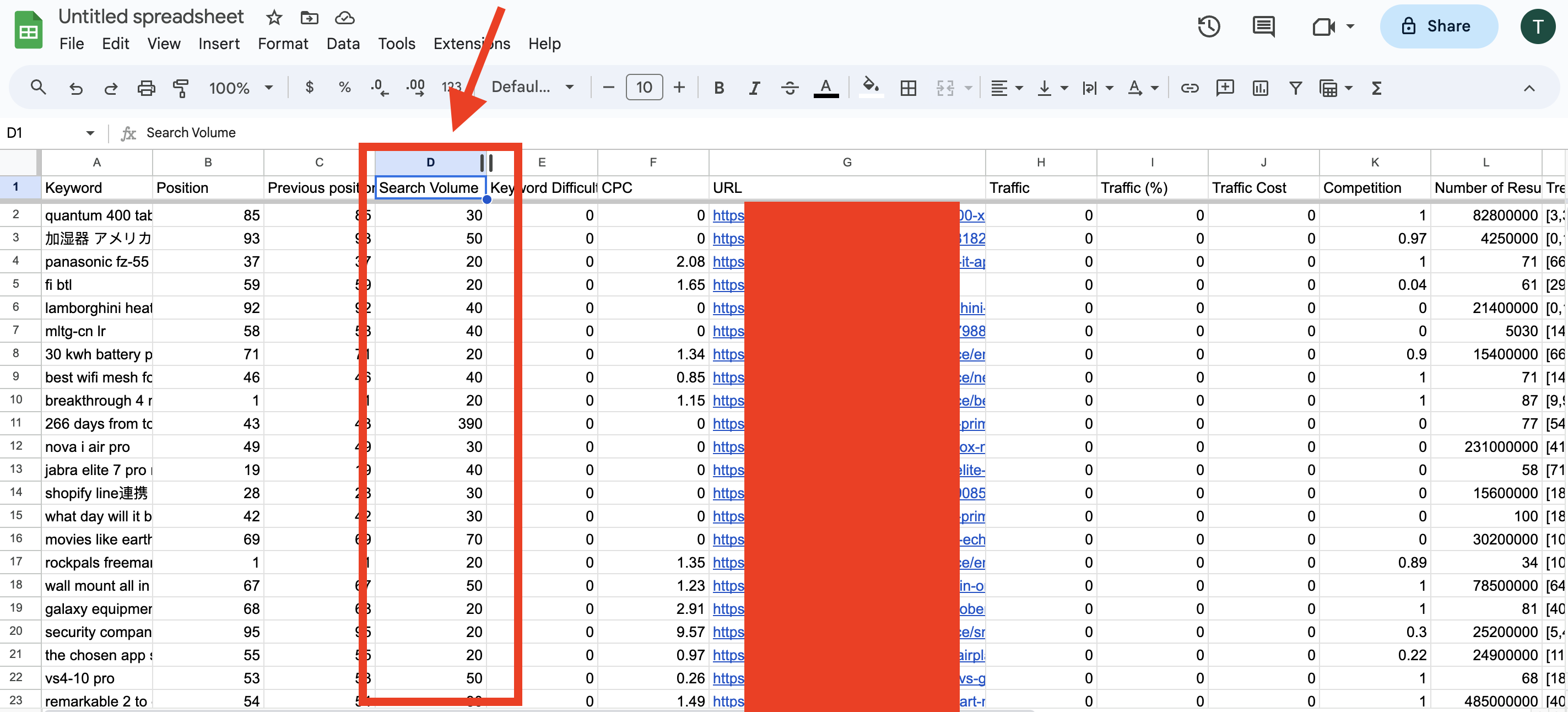
When conducting keyword research, you want to strike a balance between keyword difficulty and search volume. High search volume keywords can potentially bring more traffic to your website, but they often come with higher competition. On the other hand, low search volume keywords may be easier to rank for, but they might not generate substantial traffic.
You can see a column called Search Volume. This is estimated amount of serch quaries per month. As you can guess, it is not very productive to spend time creating content and competing for such low search volume keywords. That is why we are going to sort the sheet and find the highest serch results.
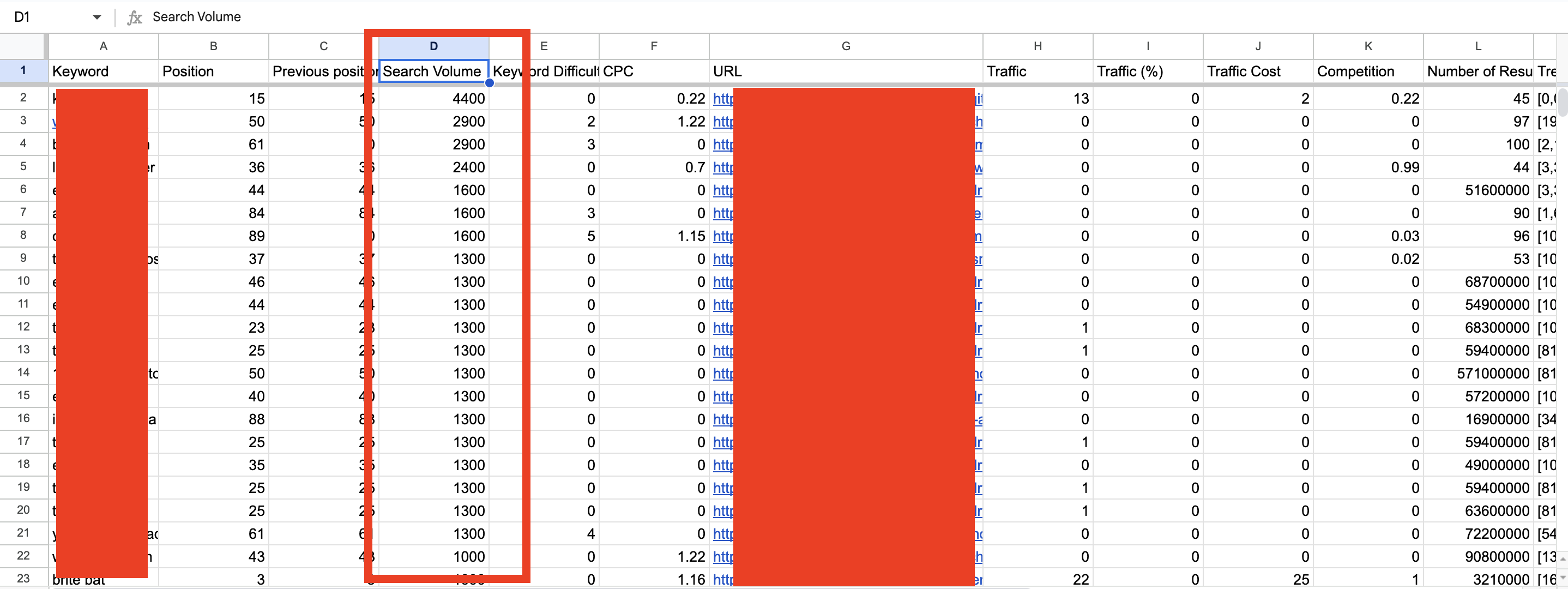
Identifying and targeting those low-competition keywords with decent traffic volume is a smart SEO strategy. These keywords can be your golden ticket to building strong content that has the potential to rank prominently in search engine results.
Repeat the process, find new competitors and make a keyword research again and again.
Also check our blog post about SEO writing.
What about backlinks?
High-quality backlinks are crucial for SEO success, but they can indeed be expensive and should be approached with caution. Low-quality or spammy backlinks can harm your website’s ranking and reputation, so it’s essential to avoid them.
If you don’t have a budget to afford high quality backlinks, it’s better to focus on the high quality content and keyword research.
If you do have budget, it is better to spend some money to hire some professional who would write strong content for your website.
That is why, me personally don’t see any reason why you should think about backlinks in the beggining of your online journey.
But if you can reach out some high authority website and negotiate a guest post for free, it would be great!
Adsterra SEO course
This one’s going to say for itself: https://blogdev.adsterratech.com/blog/seo-and-traffic-boost/
Social Media Traffic
Social media offers the advantage of delivering near-instant results, whereas SEO can take time to yield significant results. Achieving virality on social media can indeed bring a substantial influx of traffic and potential earnings. However, it’s important to note that viral success can be fleeting, and maintaining a stable online presence is essential.
Here are some notable social media platforms that can be valuable for promoting your website:
- Snapchat
- Tik Tok
- Youtube
- Linked In
- Quora
- Medium com
- Gab
We already published case studies about some of the platforms. By the way, if you already have a story how you monetize traffic from Instagram, Tik Tok, Reddit, Linked In, Quora, Medium or any other platforms feel free to share with us!
The general advice here is to follow the trends, and create content around something people interested right now. Use trend tracking tools such as YouScan or BuzzSumo. Or simply you can use Google trends.
Use trending keywords and hashtags to promote your posts, and read our tutorials and case studies on how to work with social media platforms.
Social media submissions might be good for your SEO too.
Here is what one of our publishers sent me in 2022. He had a blog about South African music.
In October 2020 he started “Pinterest and other social media submissions”. It was a long two year journey, but he managed to boost his traffic a lot.
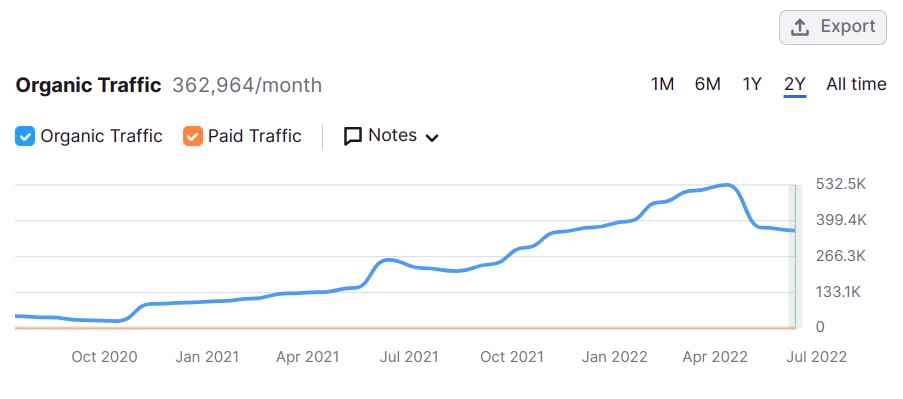
Advertising
When your website is all set up and running, when you filled it with valuable content, and traffic started to flow, it is time to make money with some ads.
The most profitable combination would be Popunder and Social bar.
You can read the stories of our publishers and learn what ad formats they used: Facebook, Pinterest, Twitter, Youtube
Conclusion
Even complex technical aspects of our work can be made simple and understandable through clear explanations. We thank our expert and believe this comprehensive guide will be a great help for any beginner. We stand for the take that Adsterra is about quality care and effective onboarding at any stage. Therefore, a full-fledged Partner Care Program with 24/7 multilingual online chat is always at your service. Join Adsterra today to start earning money as soon as possible. We’ll be happy to have you!
FAQs on how to make money from ads on my website
The amount you can earn from ads depends on several factors, including niche, audience location, ad type, and traffic level. The good news is that you can earn substantial income if you play your cards right. Websites can make thousands to millions of dollars from ads depending on the aforementioned factors.
Your earnings per 1,000 views depend on many factors, such as niche, ad network, and traffic, but don’t be afraid to aim as high as possible. So it can be $1 or less and with no limit, up to $5, $10, $20, etc, and each of these figures may be taken as a good result in their settings.
The first step is registering on a suitable ad network. Then, the ad network provides a piece of code to add to your website. Add this code to the required website section, and you should see ads on your site in no time. Adsterra is an excellent example of an ad network that gives you access to 15,000+ high-quality advertisers.
